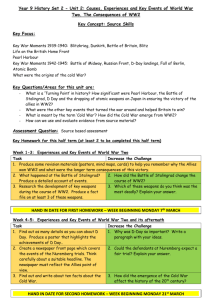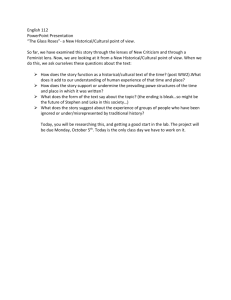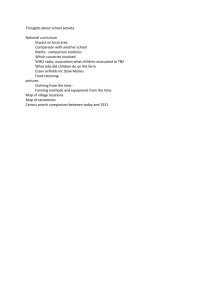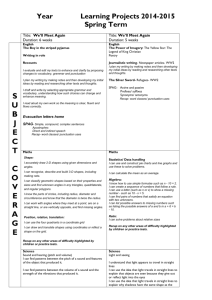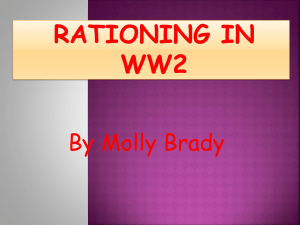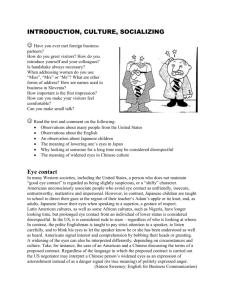C28Questions
advertisement
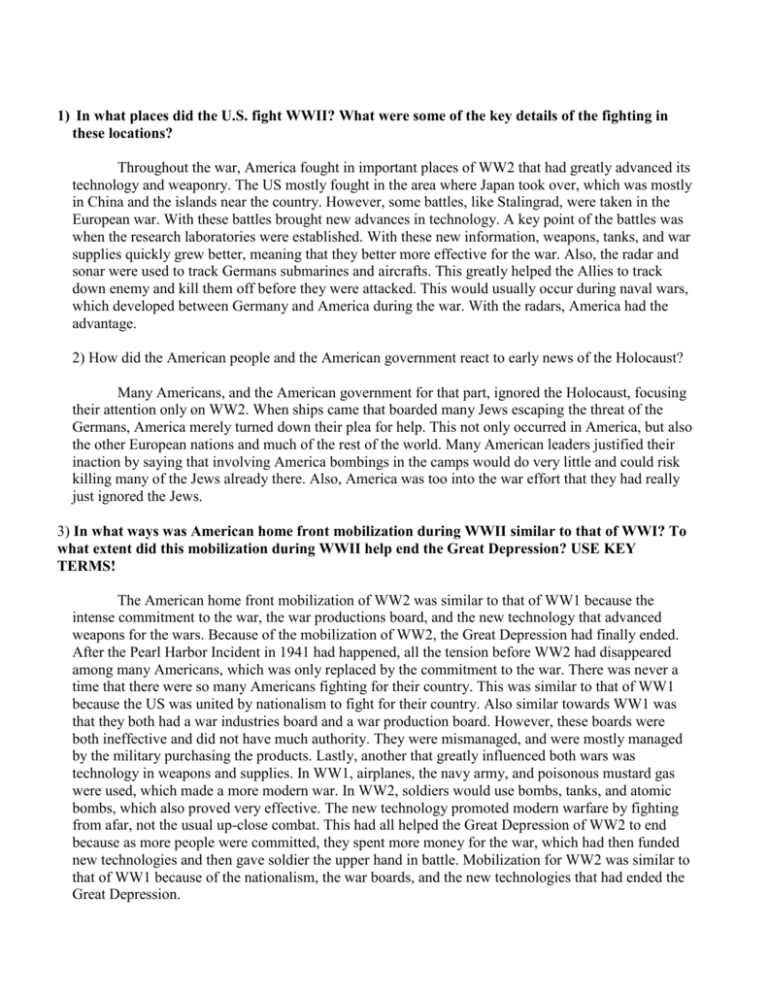
1) In what places did the U.S. fight WWII? What were some of the key details of the fighting in these locations? Throughout the war, America fought in important places of WW2 that had greatly advanced its technology and weaponry. The US mostly fought in the area where Japan took over, which was mostly in China and the islands near the country. However, some battles, like Stalingrad, were taken in the European war. With these battles brought new advances in technology. A key point of the battles was when the research laboratories were established. With these new information, weapons, tanks, and war supplies quickly grew better, meaning that they better more effective for the war. Also, the radar and sonar were used to track Germans submarines and aircrafts. This greatly helped the Allies to track down enemy and kill them off before they were attacked. This would usually occur during naval wars, which developed between Germany and America during the war. With the radars, America had the advantage. 2) How did the American people and the American government react to early news of the Holocaust? Many Americans, and the American government for that part, ignored the Holocaust, focusing their attention only on WW2. When ships came that boarded many Jews escaping the threat of the Germans, America merely turned down their plea for help. This not only occurred in America, but also the other European nations and much of the rest of the world. Many American leaders justified their inaction by saying that involving America bombings in the camps would do very little and could risk killing many of the Jews already there. Also, America was too into the war effort that they had really just ignored the Jews. 3) In what ways was American home front mobilization during WWII similar to that of WWI? To what extent did this mobilization during WWII help end the Great Depression? USE KEY TERMS! The American home front mobilization of WW2 was similar to that of WW1 because the intense commitment to the war, the war productions board, and the new technology that advanced weapons for the wars. Because of the mobilization of WW2, the Great Depression had finally ended. After the Pearl Harbor Incident in 1941 had happened, all the tension before WW2 had disappeared among many Americans, which was only replaced by the commitment to the war. There was never a time that there were so many Americans fighting for their country. This was similar to that of WW1 because the US was united by nationalism to fight for their country. Also similar towards WW1 was that they both had a war industries board and a war production board. However, these boards were both ineffective and did not have much authority. They were mismanaged, and were mostly managed by the military purchasing the products. Lastly, another that greatly influenced both wars was technology in weapons and supplies. In WW1, airplanes, the navy army, and poisonous mustard gas were used, which made a more modern war. In WW2, soldiers would use bombs, tanks, and atomic bombs, which also proved very effective. The new technology promoted modern warfare by fighting from afar, not the usual up-close combat. This had all helped the Great Depression of WW2 to end because as more people were committed, they spent more money for the war, which had then funded new technologies and then gave soldier the upper hand in battle. Mobilization for WW2 was similar to that of WW1 because of the nationalism, the war boards, and the new technologies that had ended the Great Depression. 4) Describe the situation for African Americans and women during WWII. African Americans and women were able to experience more freedom now that they could take part in the war, yet in reality, they could do little as racial prejudice and social injustice step in and barred their way for equal rights. African Americans had tried to ask the government for racial justice as they fighting the war with other white soldiers, yet the government denied them. But the CORE, the Congress of Racial Equality, allowed Blacks to eat in restaurants. This proved that their commitment and government assistance would erode away racial prejudice later after the war. As of during WW2, though, blacks were treated with injustice, yet able to fight in the navy and air force because of the need for manpower. However, they were usually given the most menial jobs. For women, since the leave of men had left them much time and no money, they had to go out themselves to work. This created more stress, which contributed greatly to limited child care, and had a rise in crimes. However, when women worked in the army, they were mostly given jobs to create weapons and serve as clerks. They were not given the opportunity to fight with the men, which resulted in the limited equality between men and women. African Americans and women of WW2 were never able to gain equal rights because there was too much status rigidness, yet they were eroding the social norms during WW2. 5) Describe the situation for Native Americans and Mexican Americans during WWII. Native Americans and Mexican Americans were able to enjoy mass employment and economical booms, yet they had also experienced racial tensions during the war and in white society. Since the demand for war supplies increase, more Native and Mexican Americans were able to find jobs more easily. Native Americans also were able to have important a job such has the “CodeTalkers” and work in the army. They had faced so much opportunity that most never wanted to turn back to the reservation. Yet, because of racial discrimination, some did not have enough money to live in white society, and had to move back to their reservations. This showed that there was still white prejudice against Native Americans. Because that face prejudice, they were given less money, which had then given them not enough money to live in white society. For Mexican Americans, they were also able to enjoy mass employment. However, since so many had to move to the cities to make transportation to their jobs easier, white prejudice tensed in any parts of the cities. This tension then created more prejudice towards these Mexican Americans, which resulted in a bad working environment. Though they were able to enjoy their jobs, constant racial prejudice reminded them that their statuses were not equal. Though Native and Mexican Americans were able to fight and serve in the war directly and indirectly, they were face with prejudice all the time in reality. 6) Describe and evaluate the situation for Japanese Americans and the changing relationship between the U.S. and China during WWII. While Japanese Americans faced internment camps, America’s relationships with Chine greatly improve as they worked together during WW2. it is quite unfair for Japanese Americans to have to be locked up for being Japanese. Two thirds of Japanese Americans were actually born America, but because of racial tension that had rose after the Pearl Harbor Incident, they were locked up. It was not fair that though the Japanese were treated like prisoners and were isolated away, the Chinese was seeing the benefit of the war. The Japanese and Chinese had always been treated with the same prejudice before WW2, but after the internment of the Japanese, Chinese status in America greatly improved. Because of the ongoing war with the Japanese to protect the Chinese from being invaded, Americans realized the importance of the Chinese, which later resulted in the repeal of the Chinese Exclusion Acts. The attitude towards Japanese Americans and Chinese Americans was very different, in which the Chinese were getting the benefits while the Chinese were enjoying less racial injustice. 7) What were the key events that led to victory for America and its allies in Europe, North Africa, and the Pacific? How did American leaders and forces particularly contribute to these key victories? USE KEY TERMS! Because of the contribution of American supplies and soldiers, America and its allies were able to effectively take back France, invade Italy, and protect the Soviet Union from collapsing. By taking France back, the Allies and Americans could easily attack Germany from the west. This also ended any effective western offensive from the Germans. America played an important role in this because they provided a mass amount of bombs. It was due to much of the bombing that the Allies were able to regain France, and with that, attack Germany from the west. Also, by invading Italy, America and the Allies also took back northern Africa and attack Germany from the south. Germany then lost control of the south. America had played another important role in this matter because General Bernard Montgomery led a successful American offensive to defeat the vast German army in the Northern Africa. Lastly, America plated an important role in the revival of the Soviet Union because of the battle at Stalingrad. This battle, successful by the Americans, drove of the Germany over in the Soviet Union, preventing them from collapsing. This had also given the Allies the advantage of attacking from the east. And with that, the Allies were able to fight Germany by surrounding it from the west, east, and south. This led to the successful defeat of the Germans. By contributing soldiers and leading successful battles, the Americans played an important role in the victory of the Allies.
